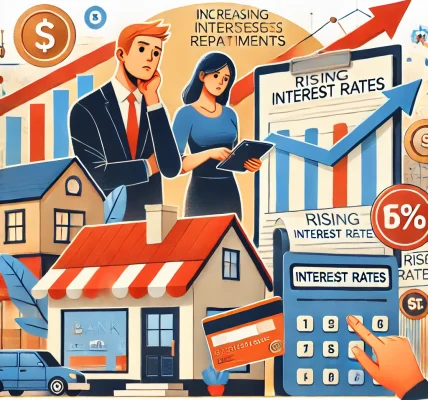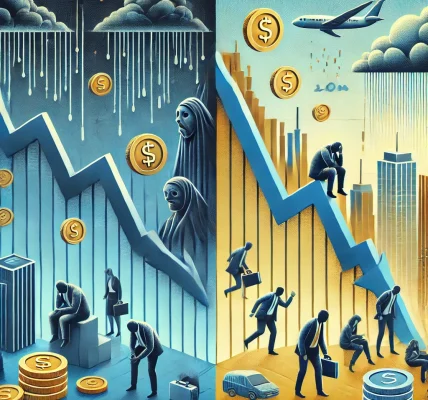Introduction
One of the biggest misconceptions about financial markets is that the stock market is a direct reflection of the real economy. While both are interconnected, they often move in different directions. Investors may celebrate record-high stock prices even during economic downturns, while strong GDP growth doesn’t always translate into rising stock indices.
Understanding the reasons behind this divergence is crucial for businesses, investors, and policymakers. This article explores why the stock market and the real economy don’t always align, the factors influencing both, and how investors can navigate these complexities.
1. The Fundamental Differences Between the Stock Market and the Economy
While the stock market and the economy influence each other, they operate under different mechanisms and respond to different stimuli.
a) Stock Market as a Forward-Looking Indicator
- The stock market represents investor expectations for future corporate earnings and economic conditions.
- Stock prices are based on factors such as monetary policy, investor sentiment, and corporate profitability.
- Markets can rise in anticipation of economic recovery, even if current economic data is weak.
b) The Real Economy Reflects Present Conditions
- Economic indicators such as GDP, employment rates, and industrial production reflect current economic performance.
- Consumer spending, inflation, and wage growth directly impact the economy but may not immediately influence stock prices.
- Unlike stock markets, economic data is retrospective and provides insights into past performance.
Key Takeaway: Stock markets react to future expectations, while economic data represents past and present realities.
2. Why Stock Markets Can Rise During Economic Downturns
Despite economic recessions, stock markets often rally. This is due to several key factors:
a) Central Bank and Government Intervention
- Interest rate cuts and stimulus packages fuel liquidity in financial markets.
- Investors anticipate future economic recovery driven by policy support.
- Quantitative easing (QE) increases money supply, which often benefits stock markets.
b) Corporate Profits vs. Employment Trends
- Stock markets are driven by corporate earnings rather than job creation.
- Companies may increase profits through automation, cost-cutting, or outsourcing, even as unemployment rises.
- Layoffs and economic slowdowns don’t necessarily impact profitability, leading to stock market gains.
c) Institutional and Retail Investor Behavior
- Large investors often buy stocks based on long-term growth potential rather than short-term economic conditions.
- Retail trading has surged in recent years, with more individual investors participating in markets via online platforms.
- Speculative trading and momentum investing can drive stock prices higher despite economic downturns.
Example: The stock market surged in 2020 despite a global economic contraction due to pandemic-induced monetary stimulus and investor optimism about future recovery.
3. Why Strong Economic Growth Doesn’t Always Boost the Stock Market
Surprisingly, robust economic growth doesn’t always translate into stock market gains. Several factors contribute to this paradox:
a) Rising Interest Rates and Inflation
- Economic expansion often leads to higher inflation, prompting central banks to raise interest rates.
- Higher interest rates make borrowing costlier, reducing corporate profits and stock valuations.
- Bond yields become more attractive, pulling investment away from stocks.
b) Overvaluation and Market Corrections
- If stock prices have already factored in future economic growth, markets may not react positively.
- Overvalued markets are prone to corrections despite strong economic fundamentals.
- Investor sentiment plays a critical role—if growth expectations fall short, stocks may decline.
c) Sectoral Performance Variations
- Some sectors, such as technology and growth stocks, benefit from low-interest environments.
- In contrast, economic booms may favor traditional industries like manufacturing and energy.
- Stock indices are weighted toward certain sectors, which may not align with overall economic growth.
Example: In 2018, the U.S. economy experienced strong GDP growth, yet the stock market ended the year lower due to interest rate hikes and trade tensions.
4. Market Speculation and Behavioral Factors
Investor psychology plays a crucial role in stock market movements, often creating disconnects from economic reality.
a) Speculation and Herd Mentality
- Traders often follow trends rather than fundamentals, leading to overvaluations or market bubbles.
- Fear and greed drive short-term volatility, making markets unpredictable.
b) Algorithmic and High-Frequency Trading
- Modern stock markets are heavily influenced by algorithmic trading, which responds to data and technical indicators rather than economic fundamentals.
- Rapid trading can cause short-term fluctuations independent of real economic conditions.
c) Media and Market Sentiment
- Financial news cycles, analyst predictions, and corporate earnings reports shape investor behavior.
- Social media and retail investor sentiment (e.g., meme stocks) can cause sudden market movements unrelated to economic fundamentals.
Example: The GameStop short squeeze in 2021 had little to do with the company’s real economic value but was driven by retail investor speculation and social media hype.
5. How Investors Can Navigate the Disconnect
Understanding the stock market-economy disconnect can help investors make informed decisions.
a) Diversification Strategies
- Maintain a balanced portfolio with exposure to stocks, bonds, real estate, and commodities.
- Avoid over-reliance on a single sector, as different industries react differently to economic changes.
b) Focus on Long-Term Trends
- Market fluctuations are common, but long-term investors benefit from staying invested.
- Identify structural growth trends, such as renewable energy, artificial intelligence, and healthcare innovations.
c) Monitor Policy and Economic Indicators
- Keep track of central bank policies, inflation rates, and corporate earnings reports.
- Understand how macroeconomic trends influence different asset classes.
Example: Investors who anticipated interest rate hikes in 2022 adjusted their portfolios by moving towards value stocks and bonds to mitigate risk.
Conclusion
While the stock market and the real economy are interconnected, they operate on different principles and timelines. The stock market is a forward-looking, sentiment-driven mechanism, whereas the real economy reflects current economic activities and fundamentals.
Understanding these differences can help investors, businesses, and policymakers navigate market trends and economic cycles effectively. Rather than assuming that stock market performance directly represents economic health, a nuanced approach considering macroeconomic indicators, policy decisions, and investor behavior is essential.
Disclaimer
This article is for informational purposes only and does not constitute financial, investment, or legal advice. Readers should conduct their own research or consult a financial advisor before making investment decisions.




